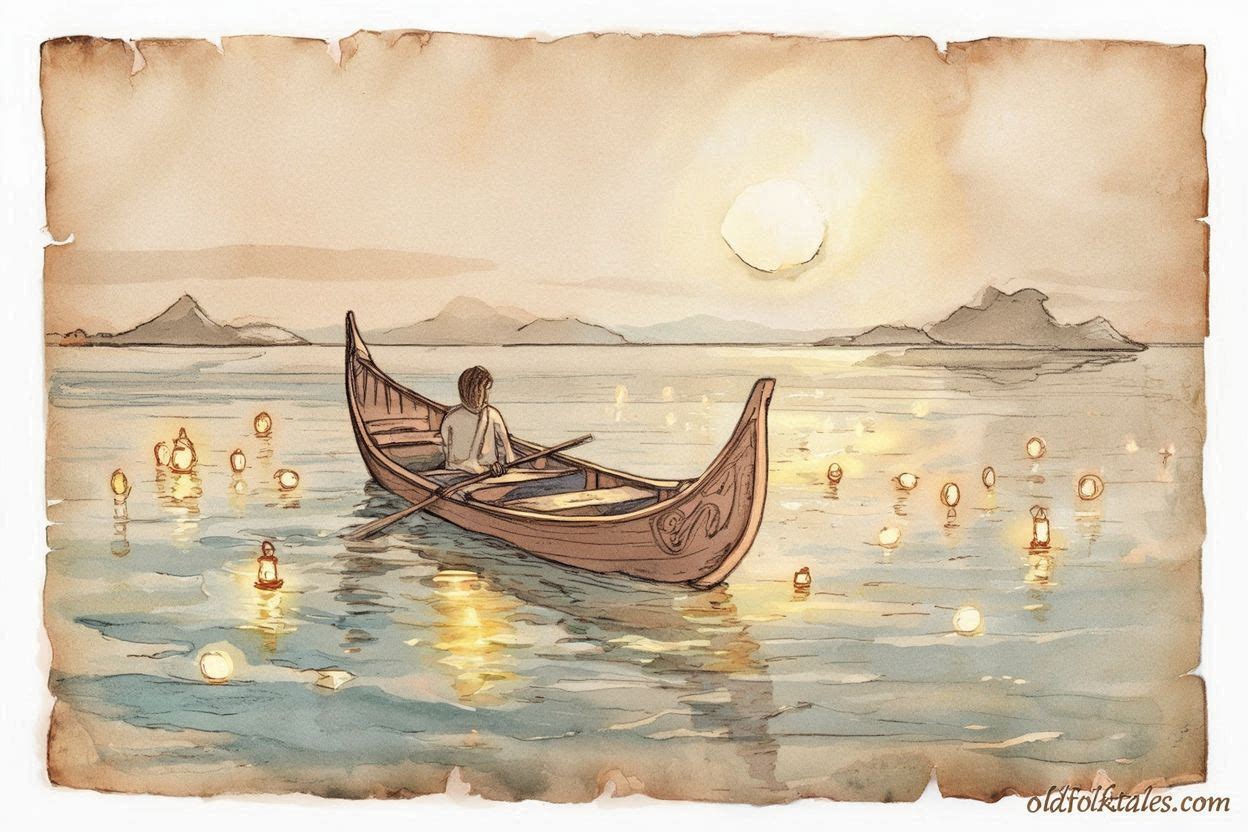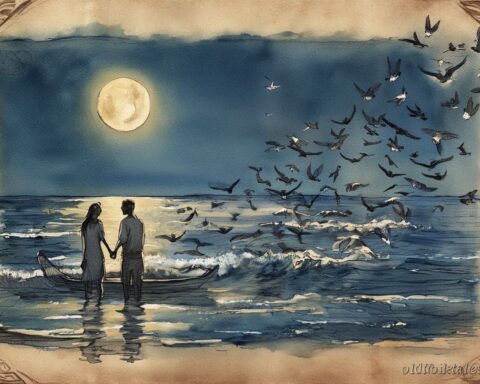In the time before the world knew separation between the living and the dead, the people of the Marshall Islands believed that every soul was born from the ocean’s breath. When life ended, the spirit did not vanish. It returned to the waves, guided by the voices of those who had gone before. This belief became the story of the Spirit Canoe of the Dead, a tale still whispered across the atolls when the moon glows upon the calm sea.
When a person’s final breath left their body, the island would fall silent. The waves softened, the palms bowed, and the elders gathered near the shore. They knew the moment had come for the soul to begin its voyage. The women prepared mats and garlands, while the men built a small fire that would burn all night. Its gentle smoke carried prayers to the horizon, where the ancestors waited.
According to the elders, the spirit of the departed rose like mist and took the form of a traveler. The gods of wind and sea, moved by compassion, shaped a canoe from the fibers of the spirit world. Its bow was made from light gathered from the stars, and its sail shimmered with the breath of ancestors. When it was ready, the spirit stepped in, and the great journey began.
The first to ever travel this path was said to be a fisherman named Naoa, who lived many generations ago. Naoa had loved the sea more than anything. He sang to it every morning and thanked it each evening for its gifts. When he grew old and his time came, he told his family not to weep but to sing him across the waves. That night, when he passed away, his people saw a soft light drift from his home toward the beach. It entered a canoe that shone like the moon, and as it sailed away, they heard his song echoing across the water. From that night, they believed that every spirit would sail to the land of ancestors in such a canoe.
The journey of the spirit was long and filled with trials. The canoe first passed through the waters of forgetting, where the soul was tested to see if it remembered the goodness it had shared on earth. If the spirit’s heart was pure, the ancestral lights appeared along the horizon to guide it. These lights, called jebal, were believed to be the torches of forefathers and foremothers, glowing softly to show the way. But if the soul had lived with cruelty or greed, the waters grew dark, and no lights appeared until forgiveness was found through the prayers of the living.
For this reason, the people of the islands honored their dead with care. They prepared offerings of breadfruit, fish, and shells and sang the ancient chants of passage. Each family had a song that called the winds to carry the spirit swiftly. The oldest elder led the chant, and the younger ones joined, their voices blending with the sound of the surf. Every note carried love and remembrance, forming a bridge between worlds.
As the canoe continued, it reached the Sea of Reflection. Here, the soul looked into the ocean and saw its life played upon the surface. All the good deeds shimmered like pearls, while the mistakes rippled as shadows. The spirit learned from both before sailing on. Then came the Islands of Rest, where kind spirits waited beneath palms that glowed with golden light. They welcomed the new traveler and offered rest before the final passage.
It was said that beyond these islands lay the horizon where the living and the dead could almost touch. On some nights, when the waves were calm and the stars bright, the people claimed to see faint canoes gliding under the surface of the sea. These lights were the souls of those who had gone before, still watching over their families. Out of respect, no fisherman cast a net or struck the water when these glows appeared. Instead, they lowered their heads, murmured blessings, and thanked the ancestors for their presence.
The Spirit Canoe of the Dead also reminded the living of their duty to one another. The elders taught that kindness, courage, and generosity were like the ropes that tied the soul’s canoe together. Without them, the spirit could drift into darkness. But when a person lived with compassion and honored both land and sea, their canoe would sail smoothly toward the afterworld.
Even today, during memorial gatherings in the Marshall Islands, families light candles or small lamps that float on the water. The glow represents the ancestral torches guiding the spirits across the ocean. The people sing songs that have been passed down for centuries, each verse telling of love, forgiveness, and peace. The sound of the chants mixes with the rolling of the tide, and in that harmony, the living feel the presence of those who came before.
The story of the Spirit Canoe teaches that death is not an ending but a continuation of the great ocean cycle. Just as waves return again and again to the shore, so do the souls of ancestors return to bless their descendants. The connection between generations remains unbroken, carried by the rhythm of the sea and the songs of remembrance.
Whenever a storm passes and the sea becomes calm again, the elders say it is because the spirits have found peace on their voyage. They remind the young ones that every act of love, every shared meal, and every song of gratitude adds light to the path of future souls. For in the Marshallese world, to live well is to sail wisely, and to die well is to journey home through love’s eternal ocean.
Moral Lesson:
The Spirit Canoe of the Dead teaches that love, kindness, and remembrance connect the living and the departed. By honoring the ancestors and living with compassion, peace and balance are maintained between both worlds.
Knowledge Check
1. What happens to the soul after death in this Marshall Islands story?
The soul travels in a spirit canoe guided by ancestral lights across the ocean to the afterworld.
2. Why do the living make offerings and sing songs for the dead?
They honor the spirit’s journey and help guide it safely to peace.
3. What materials are said to form the first Spirit Canoe?
Its bow was made of starlight and its sail from the breath of ancestors.
4. What do the glowing lights seen by fishermen symbolize?
They represent the spirits of the departed and the love they left behind.
5. What moral teaching does the Spirit Canoe convey?
That honoring the dead and living kindly keeps balance between worlds.
6. How does this story connect the people with nature?
It links the ocean, stars, and wind to the spiritual journey of the human soul.
Source:
Adapted from Spiritual Beliefs and Afterlife Stories of the Marshall Islands by the National Museum of Micronesia (2014).
Cultural Origin:
Marshall Islands Micronesia







